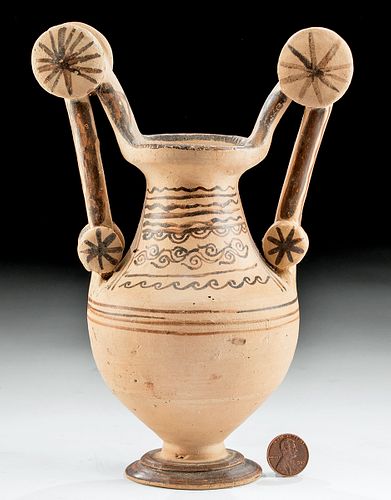Published Greek Messapian Bichrome Trozella
Lot 39a
About Seller
Artemis Gallery
686 S Taylor Ave, Ste 106
Louisville, CO 80027
United States
Selling antiquities, ancient and ethnographic art online since 1993, Artemis Gallery specializes in Classical Antiquities (Egyptian, Greek, Roman, Near Eastern), Asian, Pre-Columbian, African / Tribal / Oceanographic art. Our extensive inventory includes pottery, stone, metal, wood, glass and textil...Read more
Categories
Estimate:
$2,000 - $3,000
Absentee vs Live bid
Two ways to bid:
- Leave a max absentee bid and the platform will bid on your behalf up to your maximum bid during the live auction.
- Bid live during the auction and your bids will be submitted real-time to the auctioneer.
Bid Increments
| Price | Bid Increment |
|---|---|
| $0 | $25 |
| $300 | $50 |
| $1,000 | $100 |
| $2,000 | $250 |
| $5,000 | $500 |
| $10,000 | $1,000 |
| $20,000 | $2,500 |
| $50,000 | $5,000 |
| $100,000 | $10,000 |
| $200,000 | $20,000 |
About Auction
By Artemis Gallery
Feb 13, 2020
Set Reminder
2020-02-13 10:00:00
2020-02-13 10:00:00
America/New_York
Bidsquare
Bidsquare : Exceptional Antiquities, Asian, Ethnographic
https://www.bidsquare.com/auctions/artemis-gallery/exceptional-antiquities-asian-ethnographic-4848
An important one-day auction featuring museum-worthy examples of Egyptian, Greek, Roman, Etruscan, Near Eastern, Far East / Asian, Pre-Columbian, African / Tribal, Oceanic, Native American, Spanish Colonial, Russian, Fossils, Ancient Jewelry, Fine Art, so much more! Artemis Gallery info@artemisgallery.com
An important one-day auction featuring museum-worthy examples of Egyptian, Greek, Roman, Etruscan, Near Eastern, Far East / Asian, Pre-Columbian, African / Tribal, Oceanic, Native American, Spanish Colonial, Russian, Fossils, Ancient Jewelry, Fine Art, so much more! Artemis Gallery info@artemisgallery.com
- Lot Description
Classical world, Southern Italy, Apulia, Messapian tribe, ca. 5th to 3rd century BCE. A stylish example of the most famous Messapian form, the trozella (sometimes "trozzella"). The vessel has high strap handles, each punctuated at the top by round "wheels" ("trozella" means, in the local dialect, "little wheels"). The body is graceful, with a pronounced rim that flows seamlessly into the handles, and the entire piece stands on a short leg above a round foot. Around the body are well-rendered, horizontal bands - some linear, some waveform, some interlocking swirls - all in an umber hue atop a creamy-beige ground. Each trozella features a spoke-like motif. A beautiful example! Size: 5.45" W x 7.6" H (13.8 cm x 19.3 cm)
Although the Messapian people were influenced by Greek colonists in other parts of southern Italy, they had a distinctive culture that included burial practices uniquely their own - and their distinctive terracotta form, the trozella, played a role. Unlike the Greeks in Apulia, Messapians reused their tombs for several burials, probably from the same family. Whenever a tomb was reused, the earlier grave goods were removed, along with the body, and then reburied inside or outside the same tomb. In this culture, grave goods indicated both social standing and gender, and the trozella is only found in the graves of women. The quality of the artwork on this trozella suggests that it was placed in the tomb of a high status woman.
Published in "Kunst der Antike", Katalog 15, 2001, no. 144.
Provenance: private New York, New York, USA collection; ex-Galerie Günter Puhze, published: Kunst der Antike, Katalog 15, 2001, no. 144
All items legal to buy/sell under U.S. Statute covering cultural patrimony Code 2600, CHAPTER 14, and are guaranteed to be as described or your money back.
A Certificate of Authenticity will accompany all winning bids.
We ship worldwide and handle all shipping in-house for your convenience.
#153098Tiny repair to foot as well as a repair to the side of one handle; otherwise in lovely condition. Both of these repairs are well done and difficult to discern. All pigment is original and well preserved, with light deposits on the surface.Condition
- Shipping Info
-
All shipping is handled in-house for your convenience. Your invoice from Artemis Gallery will include shipping calculation instructions. If in doubt, please inquire BEFORE bidding for estimated shipping costs for individual items.
-
- Buyer's Premium



 EUR
EUR CAD
CAD AUD
AUD GBP
GBP MXN
MXN HKD
HKD CNY
CNY MYR
MYR SEK
SEK SGD
SGD CHF
CHF THB
THB
















